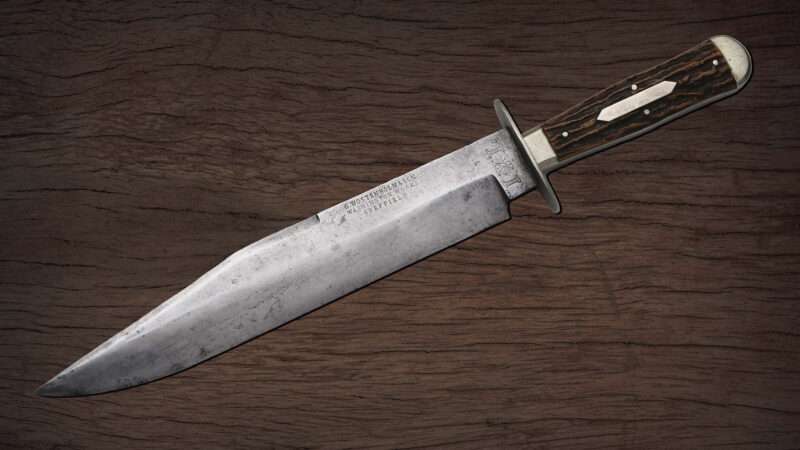
Controversial arms are nothing new in the United States. During the 19th century, there were widespread concerns about criminal use of arms such a Bowie knives, slungshots, blackjacks, and brass knuckles. The full history of state, territorial, and colonial laws about controversial arms is detailed in my recent article for Notre Dame's Journal of Legislation, The History of Bans on Types of Arms Before 1900, coauthored with Joseph Greenlee.
Because the article is thorough, it is enormous: 163 pages of text, and 1,563 footnotes. The student staff for volume 50 of the Journal of Legislation was spectacular. Not every law journal has staff who could handle such a megillah, let alone a staff that whose meticulous cite-check would improve the article.
The mainstream American approach to controls of the above arms were: 1. bans on concealed carry; 2. limits on sales to minors, such as requiring parental permission; and 3. extra penalties for misuse in a crime. Sales bans were the minority approach, and possession bans very rare.
From 1607 through 1899, sales bans for nonfirearm arms were:
- Bowie knife. Sales bans in Georgia, Tennessee, and later in Arkansas. Georgia ban held to violate the Second Amendment. Nunn v. State, 1 Ga. 243 (1846).
- Prohibitive transfer or occupational vendor taxes in Alabama and Florida, which were repealed. Personal property taxes at levels high enough to discourage possession by poor people in Mississippi, Alabama, and North Carolina.
- Dirk (a type of fighting knife). Georgia (1837) (held to violate Second Amendment); Arkansas (1881).
- Sword cane (a sword concealed in a walking stick). Georgia (1837), held to violate the Second Amendment. Arkansas (1881).
- Slungshot or "colt" (most typically, a lead weight held in the tip of a flexible bludgeon). Sales bans in nine states or territories. The Kentucky ban was later repealed. Illinois also banned possession.
- Sand club or blackjack. New York (1881), (1884), (1889), (1899).
- Billy. New York (1881), (1884), (1889), (1899).
- Metallic knuckles. Sales bans in eight states, later repealed in Kentucky. Illinois also banned possession.
- Cannons. No bans. Restrictions on discharge without permission in a variety of municipalities.
American bans on possession or sale to adults of particular types of firearms were:
- Georgia (1837), all handguns except horse pistols. Held unconstitutional in Nunn v. State, 1 Ga. 243 (1846).
- Tennessee (1879) and Arkansas (1881). Bans on sales of concealable handguns. Based on militia-centric interpretations of the state constitutions, the laws did not ban the largest and most powerful revolvers, namely those like the Army or Navy models.
- Florida (1893). Discretionary licensing and an exorbitant licensing fee for carry of repeating rifles. Extended to handguns in 1901. The law was "never intended to be applied to the white population" and "conceded to be in contravention of the Constitution and non-enforceable if contested." Watson v. Stone, 148 Fla. 516 (1941) (Buford, J., concurring).
Earlier this month, the en banc Fourth Circuit, by a 10-5 vote, upheld Maryland's ban on common rifles dubbed "assault weapons." Judge Wilkinson's majority opinion cited the article 16 times, and Judge Richardson's dissent cited it 9 times. Bianchi v. Brown, 2024 WL 3666180 (4th Cir. 2024) (en banc).
The article has also been cited in three U.S. District Court opinions supporting the claims of Second Amendment plaintiffs. Association of New Jersey Rifle & Pistol Clubs, Inc. v. Platkin, 2024 WL 3585580 (D.N.J. July 30, 2024); Miller v. Bonta, 699 F.Supp.3d 956, 981 n.86, 987 n.107 (S.D. Cal. 2023); Duncan v. Bonta, 695 F.Supp.3d 1206, 1242 n.177 (S.D. Cal. 2023). And in a Third Circuit dissent disagreeing with Second Amendment claims. Lara v. Commissioner Pennsylvania State Police, 91 F.4th 122, 144-45, 147 (3d Cir. 2024) (Restrepo, J., dissenting).
As the cites indicate, judges can disagree about how strictly or broadly to draw historical analogies, and about what sorts of laws create an established tradition at a given level of generality. It is at least helpful, I hope, that judges can have access to a common set of facts about the historical regulation of controversial arms.
The post The History of Bans on Types of Arms Before 1900 appeared first on Reason.com.







